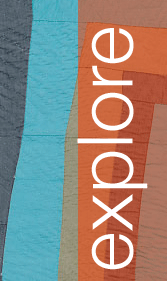KYES STEVENS
The Role of the Farm Security Administration Photographs in Understanding Gee's Bend
To help understand the context from which the quilts from Gee's Bend come, any viewer needs a foundation in history. The importance of scope in this history is essential in helping students understand facets of history are more complex than what is presented in the pages of a book, or on the wall at the museum. What they are seeing is part of the story—and the more parts of the story they can come to understand, the more complete view of that history they will have.
To gain some historical understanding of an area—that stretches beyond the most obvious documented events, a student or a researcher must do some digging. And when they find something—like a series of photographs, the entire context of the series must be explored in order to understand the perspective from which they were taken. The images are not just simple images—snapshots that explain a situation. There is a whole cultural and political context from the Great Depression era that influences how what the Farm Security Administration (FSA) photographers saw.
The photographs of Marion Post Wolcott and Arthur Rothstein have played an important role in creating a visual identity for the community of Gee's Bend, AL. How images are used in any kind of written text plays an important role in the understanding of the material presented in the text.
Using the photographs of the FSA—a program of the New Deal, students and teachers can learn to explore more critically the documents of history—and the stories behind those documents.
To help students see more clearly that a great deal of written and understood history is based on point of view and how one engages with the historical material, helping them explore the photographs of Gee's Bend—and even others in the state—will help them learn to challenge the source of material—to ask questions about authenticity and intention. In short, it will help them become more critical in their inquiries into any subject.
Exploration possibilities can include:
- What role did photography play in the “discovery” of the quilts from Gee's Bend?
- Photography as art vs. photography as documentation
- Photography as historical documentation—what constitutes fact?
- the work of Dorothea Lange, Arthur Rothstein, Marion Post Wolcott, Walker Evans
- the role of the FSA in Alabama
- presentations of race and class in images
- presentations of gender in images
- role of propaganda and the media in disseminating that propaganda.
- Authorial/Creator intention
- History/photos/quilts as catalysts for creative writing
- With more advanced students—probably past the middle school age—students can explore the idea of who is writing history -->what is the history of writing history?-->who is telling which story and does that matter?
- The New Deal during the depression—successes and controversies
To see the images of the FSA go to:
- http://memory.loc.gov/
Possible Search Entries Include:
- Alabama
- Gee’s Bend
- Marion Post Wolcott
- Arthur Rothstein
- Walker Evans
- 8a40082t
- 8a40082u: Florence Wright, recreation supervisor, directs games with adult class. Gee’s Bend, AL. MPW, 1939, May?
- 8a40097u
- 8a40098: Supervised games with school children, Gee’s Bend, AL. MPW, 1939, May?
- 8a40119u: N.R.A. and Lindberg Pettway, sons of Nolan Pettway, Gee’s Bend, AL. MPW, 1939, May?
- 8a44597u
- 8b35946u
- 8a44597u
- 8b29516v
- 8b35939u: Negroes at Gee’s Bend, Ala. Descendants of slaves of the Pettway plantation. They are still living very primitively on the plantation. Gee’s Bend, AL, AR, 1937, Feb.
- 8b35942u: Girl at Gee’s Bend. AR, 1937, April.
- 8b35946u:Sewing a Quilt. Gee’s Bend, AL. AR, 1937, April.
- 8b35953u: Gee’s Bend Family. Gee’s Bend, AL. AR, 1937, April.
- 8b35958u: Working in the Garden, Gee’s Bend, AL. AR, 1937, April.
- 8b35966u: Pat Bendolph, one of the tenants at Gee’s Bend, AL. AR, 1937, April.
- 8b35967u: One of the cabins on the old Pettway plantation. Gee’s Bend, AL. AR, 1937, Feb.17. 8b38853: Footpaths across the field connect the cabins. Gee’s Bend, AL, AR, 1937, April.
- 8c09994u: Part of old house and new home of Little Pettway’s family. Gee’s Bend, AL. MPW, 1939, May.
- 8c10017u: Juanita Coleman (Miss or Mrs.), teacher and NYA (National Youth Administration) leader, listening to one of her pupils in adult class read. Gee’s Bend, AL, MPW, 1939, May.
- 8c10021u: Nurse Shamburg gives Viola Pettway instructions. . . , MPW, 1939, May.
- 8c10028u: Jorena Pettway sorting peas inside her smokehouse. She still has many fruits and vegetables which she canned last year. Gee’s Bend, AL. MPW, 1939, May.


